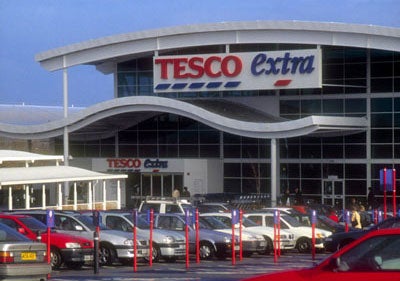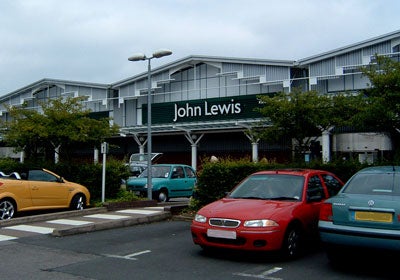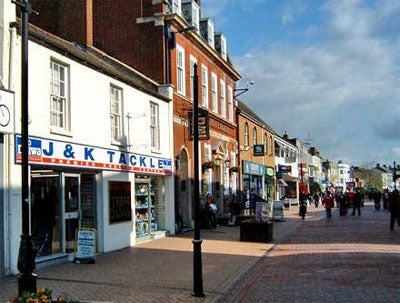Tesco, the Internet and TackleSEEMS THERE’S BEEN a bit of paranoia spreading amongst the tackle trade recently because the likes of Tesco, Aldi, and Lidl, are selling fishing tackle. Will this spell the end of the local tackle shop? Oh, come on, please! (cynically said).
I’ll bet there’s a lot of anglers reading this who started fishing simply because they saw tackle for sale in Woolworths in the 70s and 80s. Those sales did the trade no harm at all; on the contrary, I believe they would have improved trade. Let’s face it, one trip to a local fishery with ill-matched tackle and local experienced anglers would soon put them right and tell them where the nearest decent tackle shop was. Result, another new customer for them! A Bit of History Way back in 1966 I was working for the CWS in Manchester in their drapery department. This wasn’t serving old ladies with 3 yards of cretonne for their kitchen window, it was selling whole pieces (40 yard rolls) of soft furnishings fabric to the smaller retail cooperatives, arranging shows, sometimes visiting their stores with our reps. We also worked with the other departments within drapery and it was from this that our regional manager, John Yelland, got the idea that we should be selling some items through supermarkets and grocery shops. John was a young dynamic sort who I’d known for about 4 years prior to him taking over his new roll and it was as part of a conversation that he dropped in, “How would you like to work with Jack (Hampson) on pushing some of our dry goods through the grocery stores?” At that time life was getting really tedious in Manchester and the chance to get out on the road more often seemed to suit me. So, we (Jack and I) went around all the departments looking at small dry goods items that we could introduce to the grocery trade. Most of the stuff came from Household Linens Department and Haberdashery, dish cloths, dusters, combs, needles, all that sort of thing. We put a fair old range together with samples and off we went around all the grocery shows, Birmingham, Cardiff, Newcastle, Leeds, and we did quite well. That’s when I found out that Tesco were doing exactly the same thing, selling lots of dry goods items near the checkouts. Did that kill off the drapery stores? Well, the whole manner of selling drapery items was changing anyway. I mention this story, though, to show that I have had experience in this kind of trade and we covered a lot of supermarket selling techniques in the commercial courses I was doing at college. A New Idea? So is selling fishing tackle through the supermarkets a new idea? Not really, a little over ten years ago I was doing some work with Sid Sarbutts (a nice guy and still going strong I believe) of Mustad UK.
I suggested to him, because of his vast experience in the tackle trade, that manufacturers should be selling tackle through the larger stores, not just supermarkets, but outlets like John Lewis Partnership. The idea being to identify a range of products from either a single source or a multiple of sources and labelled up to ease the choice of the buying public. There would be groups: 1 – light fishing with floats A simple A4 leaflet would explain these groupings simply and the tackle offered would carry labels identifying their respective group, ie: GROUP 2 rods go with GROUP 2 reels. A further choice of ready made-up blister packs would also be available containing bits and pieces of end tackle, hooks to nylon, shot, disgorger, etc, necessary to complete the kit. So, all the customer had to do was select what type of fishing they wanted to do and select a rod, a reel, and a blister pack from the appropriate group. Things like landing nets could be labelled ‘GROUPS 1 & 2’ for example. You can see that the purpose was that no-one should walk out with a very light float rod and a huge carp reel or vice versa – and that can happen! I floated the idea amongst a few companies who could have done the whole package on their own, but sadly there seemed little interest. Not really the kind of market they feel their product would fit, too much effort required for little return. I wonder if they held the same view of Internet selling then? So, disheartened I abandoned the idea, but strangely after 6 months or so Chris Leibbrandt, one of those I had approached who was then MD of Masterline, introduced John Wilson fishing packs to the world. Coincidence or what, I don’t know and furthermore I don’t care, but I do see a missed opportunity. If anyone wants to run with this idea now, I am still available (hint, hint) to help out and I do believe there’s still time to turn this around. The tackle required, and there’s even more choice now and better quality, would need to be carefully selected so you’re not selling garbage at the expense of an unknowing public. ‘Match’ rods are OUT because the public do not understand what a match rod is, so they have to be labelled ‘Float’ rods. Same with poles, these should be elasticated ready for use and not labelled ‘Animal Hanger’, but rather ‘Carp Pole’ (and this isn’t just PC, it’s the fact that the inexperienced public aren’t used to our silly names for poles). Do We Need The Big Stores? Yes, indeed we do. There are very few tackle dealers now that have high street prominence. You know where they are, they’re typically down side streets where the rent and rates are cheaper, but the downside is, no-one else knows they’re there. However, people do visit supermarkets on a weekly basis and many sales are made now on a spur of the moment decision, particularly with non-grocery items.
Use this as the ‘Woolworths’ experience. The more people see fishing tackle, the more people will buy it, the more anglers there are, the healthier the tackle trade is in general. How many of those Woolworths tackle buyers are now committed anglers buying top quality gear from proper tackle retailers? No prizes for guessing and they were sales that the tackle dealer would never have had anyway. Tackle dealers have little to fear from supermarkets because for one thing, it’s unlikely that they’ll ever sell live baits like maggots. I can never see Mrs Silcott-Smythe laying her groceries out on the moving belt next to where young Jimmy Smither’s has just put a tub of oily hempseed, a pint of creepy-crawly maggots and a tub of dendrabenas in peat. It’s just never going to happen so other than making an initial sale of hardware, the stores will have to pass the buyer over to the local dealer and if those buyers are like me in hoarding tackle, the tackle dealers will have a very bright future. More to Fear from the Internet This is the market that will affect tackle dealers the most. In marketing speak, the size of the cake is only so big and so if any dealer from outside your area is taking your sales, that is directly affecting your business. The big stores, on the other hand, will help grow the market at least, but the big question being, when the market is bigger where will it spend its new money? I don’t think I’ve ever seen any figures to suggest what percentage of tackle sales are made in-store at local dealers, but a conservative guess would only be between 25 and 40%. You only have to look at the successful mail order stores to see how much they’re turning over, especially in the larger items, rods, reels, bivvies, luggage, chairs and beds, etc. So, if any other dealers open up in that market, another established mail order dealer or worse still, another shop owner, is only going to suffer, but that’s what competition is all about. What of that other four-letter word that seems to raise the hackle of every tackle retailer – eBay? Call it all you will, but many successful deals are made through eBay and there are a good many successful dealers involved in it. “Pah! They don’t have shops, just someone operating from home.” Not quite so for one of the most successful on eBay has, I believe, three tackle shops around the north east and she now has close to 13,000 stars (customers) to her name. Yes, like her or loathe her, it’s Kathryn’s Tackle and I’ll bet she (if it is a she) has had more customers through eBay than most shops have had through their front doors in the same time. Again, it’s another selling medium that is ignored largely through fear. The beauty of the Internet is that you can shop truly ‘at your leisure’, at 10 or 11 o’clock at night if you wish. I even buy little things like batteries now on the Internet, I buy all my artists paints and even some DIY tools on the internet. Recently I bought my new boat through the Internet and sold my old one through the Internet and my son found his new house – through the Internet. Now don’t get me wrong, I’m not saying you should ignore your local dealer. I believe he should be given every opportunity to make a sale and in a great many cases you might find he can offer the same deal as the Internet shops taking postage, etc, into account. It’s the fact that he isn’t open all hours and the Internet is always there at the time when you want to shop. You place the order, enter your card details and two days later (normally) the goods are delivered to your door and if it’s a recognised brand name or you’ve seen someone using the item already or read a report, it’s hardly blind buying. There are four main areas where dealers can operate, from a shop, mail order from magazine advertising, on the Internet websites, or on eBay. It’s a free market, it’s their choice, but one thing is for sure, none of these methods of selling is going to make the market any larger. The big stores might. |
Welcome!Log into your account













